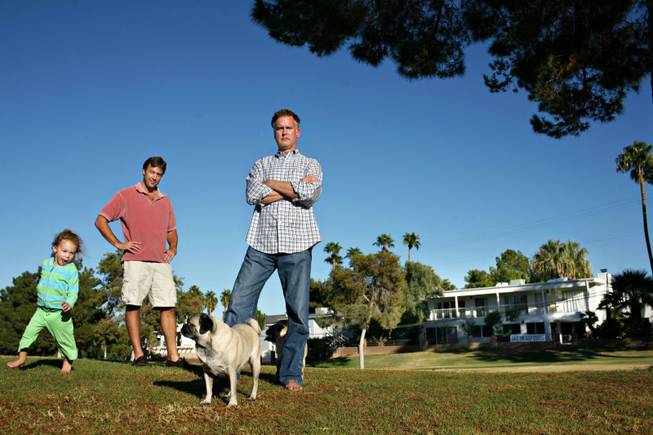
Tiffany Brown / FILE
Cab Bennett, left, and David Caldwell own homes that border Las Vegas National Golf Club. They are among the neighbors of the course who are trying to save it.
Tuesday, Sept. 9, 2008 | 2 a.m.
Beyond the Sun
Lines are being drawn in the sand traps that pockmark the otherwise pristine 130 acres of lush green sod at the Las Vegas National Golf Club.
The course’s neighbors in Paradise Palms — the 1960s neighborhood used for home scenes in the movie “Casino” — are to meet tonight to talk about raising money because they expect they will have to go to court to stop a plan to build houses on the golf course.
Investors bought the 130-acre course along Desert Inn Road at Eastern Avenue for $33.2 million in August 2007. Paradise Palms residents say they’ve heard from one of those investors — John Knott II, executive vice president of the CB Richard Ellis real estate brokerage — that this month or next he will submit to the county a tentative plan to build a 485-home neighborhood on the course where the likes of Arnold Palmer and Tom Kite have won pro tournaments. In 1996,
20-year-old Tiger Woods scored his first pro tournament win in the last Las Vegas Invitational held on the course.
These days, however, the course needs to bring in more golfing tourists, Knott wrote in a letter to Paradise Palms homeowners late last month. Knott also noted that a payment on a loan used to purchase the course will come due in August 2009.
To secure refinancing — and to give the golf course owners time for their plans to reinvigorate their business to work — investors need to “claim the residential use value” of the course, he wrote. He goes on to explain that if the investors can’t get the refinancing, “the pressure will grow to achieve maximum value at the earliest possible date.”
The golf course’s neighbors read the letter as acknowledgment that the new owners are considering replacing the course with homes.
Clark County Commissioner Chris Giunchigliani, who represents the area, said there’s “nothing we can do” to stop Knott from submitting the housing plan.
And, she said, “if it conforms to the current zoning, there’s really no argument that can be made (by the county) against it.”
Knott could not be reached for direct comment. His assistant said the proposal had not yet been completed.
Paradise Palms residents aren’t sitting back and waiting, however. They have spent months researching and organizing. A year ago they put a “Keep the golf course a golf course” Web site online, including taped testimony from residents and others who abhor the elimination of the course.
One of those interviewed, state Assemblyman Richard “Tick” Segerblom, said Monday he was “absolutely outraged” at the idea of homes on the golf course.
“What a nightmare to take a gorgeous place like that and try to build homes,” said Segerblom, who represents the area. “There’s got to be a way to stop it, and I think it will be stopped.”
For one thing, a massive plume of toxic chemicals lies beneath part of the golf course. The Nevada Environmental Protection Division confirmed the presence of a plume of tetrachloroethylene, which has caused liver and kidney tumors in lab animals. The contamination is alleged to have come from a dry cleaning business.
“I can’t believe the county would let anybody subdivide a piece of property where there’s a toxic plume underneath,” Segerblom said.
“It’s a valid issue to take a look at,” Giunchigliani said.
Segerblom also said that when the course was built, it may have been zoned “R-1,” which allows residential, single-family homes, but he doesn’t think the builders ever intended it to be anything other than a golf course.
Local attorney Matthew Callister, who is doing what he can to fight a 2,900-acre gun range in the northern part of the Las Vegas Valley, said one legal argument that works these days is that there was a lack of disclosure — that is, if home buyers were not told the golf course could one day become homes.
“It goes to due process,” Callister said. “If you were informed, would you have made the same decision, the same purchase?”
The course was originally owned by the Stardust casino. Longtime Las Vegas developer Irwin Molasky was one of the developers around the course. He could not be reached for comment Monday.
Segerblom said if the original intent was to someday allow homes where a course now stands, any development there should be at the density level expected in the early 1960s. That is, three homes per acre instead of the more profitable five homes per acre that is allowed today.
“That might make it a little more economically unfeasible, keep someone from trying to make a quick buck,” Segerblom said.
Any intent to build homes today is stalled by the slump in the housing market in Las Vegas, so “this is, by no means, a slam dunk,” said Wayne “Skip” Cummins, 47, a homeowner who has helped spearhead the neighborhood fight.
Sure the housing market will eventually rebound, but when it does, will the prospect of living in an older part of Las Vegas appeal to home buyers, wonders Cummins’ neighbor Cab Bennett.
“Who’s going to buy a house here?” said Bennett, who lives there with his wife and young daughter. “The golf course is the only thing that gives it a sense of worth.”

Join the Discussion:
Check this out for a full explanation of our conversion to the LiveFyre commenting system and instructions on how to sign up for an account.
Full comments policy